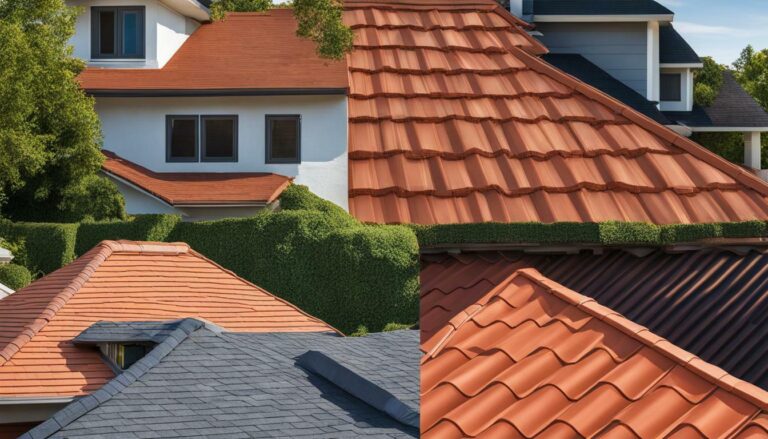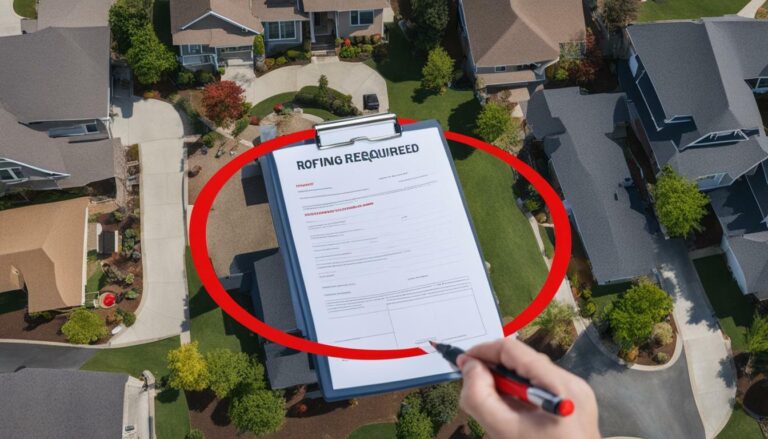Essential Roof Maintenance Tips to Protect Your Home
When it comes to protecting your home, ensuring the health of your roof is paramount. Regular roof maintenance is key to extending its lifespan and preventing costly repairs down the line. In this section, we will explore essential roof maintenance tips that will help safeguard your home and keep your roof in optimal condition.
- Thoroughly inspect your shingles each season for signs of wear or damage.
- Treat for moss, lichen, and algae annually to prevent damage and maintain appearance.
- Clean and maintain gutters to ensure water and debris are properly directed away from your roof and home foundation.
- Regularly remove leaves and debris from your roof to prevent damage and the growth of moss, lichen, and algae.
- Trim branches hanging near your roofline to prevent damage from falling branches during storms.
By following these roof maintenance tips, you can protect your home from potential damage and ensure the longevity of your roof. Remember, it’s always wise to consult professional experts for all maintenance and repairs to guarantee the best outcomes for your roof.
Thoroughly Inspect Your Shingles Each Season
When it comes to maintaining your roof, one of the most crucial tasks is to regularly inspect your shingles for signs of wear or damage. By conducting a thorough inspection each season, you can identify any issues early on and take appropriate measures to address them. This proactive approach will not only protect your home but also prolong the lifespan of your roof.
During your inspection, pay close attention to any signs of wear such as cracking, curling, or missing shingles. These can be indicators of age or weather-related damage and should be addressed promptly to prevent further issues. Additionally, be on the lookout for signs of damage caused by external factors like fallen tree branches, excessive moss or algae growth, or animal activity.
If you notice any abnormalities or signs of wear, it is recommended to consult a professional roofing contractor for a comprehensive evaluation and necessary repairs. They have the expertise to accurately assess the condition of your roof and provide appropriate solutions to ensure its integrity and longevity.
| Signs of Wear or Damage | Recommended Actions |
|---|---|
| Cracked or curling shingles | Replace damaged shingles to prevent leaks. |
| Missing shingles | Replace missing shingles to maintain an even and watertight surface. |
| Excessive moss or algae growth | Treat the affected areas to prevent further damage and maintain the aesthetic appeal of your roof. |
| Damaged shingles due to fallen branches or animal activity | Repair or replace the affected shingles to restore the structural integrity of your roof. |
Remember, a well-maintained roof is essential for protecting your home and ensuring your safety. By thoroughly inspecting your shingles each season and addressing any signs of wear or damage, you can prevent costly repairs and maintain a secure and comfortable living environment.
Tips for Shingle Inspection:
- Use a ladder and exercise caution when accessing your roof to inspect the shingles.
- Wear appropriate safety gear, including non-slip shoes and a harness if necessary.
- Check for signs of wear or damage on each shingle individually, paying attention to corners, edges, and areas prone to water accumulation.
- If you are unsure about the condition of your shingles or notice any concerning signs, consult a professional roofing contractor for a thorough assessment and guidance.
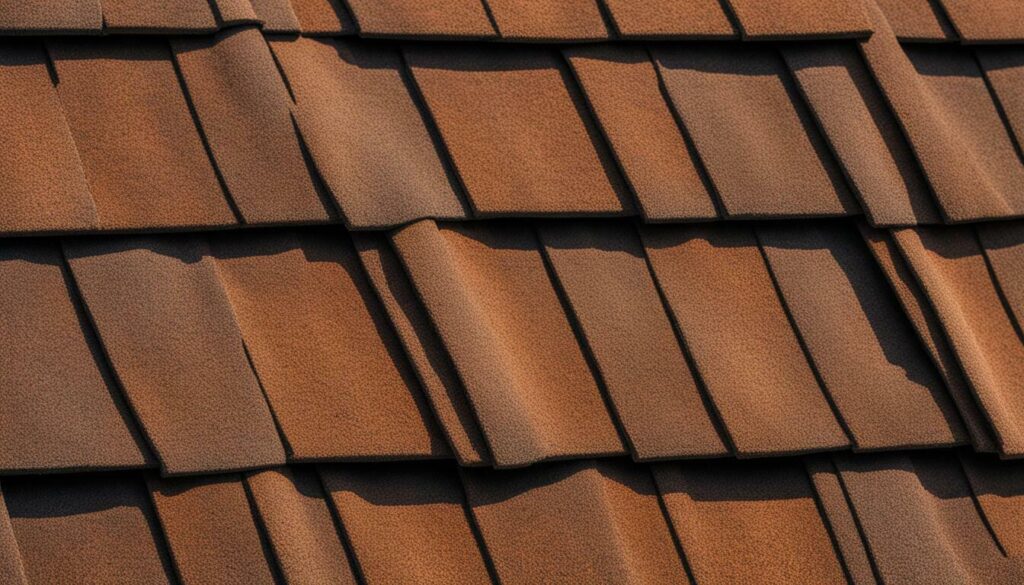
Moss, lichen, and algae can wreak havoc on your roof if left untreated. Not only can they cause unsightly stains and discoloration, but they can also lead to structural damage over time. That’s why it’s crucial to incorporate regular moss treatment, lichen prevention, and algae maintenance into your roof maintenance routine.
One effective method of treating moss, lichen, and algae is through the use of specialized cleaning solutions. These solutions are designed to kill and remove these organisms without causing harm to your roof or the environment. It’s important to choose a product specifically formulated for roof cleaning, as using the wrong chemicals can cause more harm than good.
When applying the cleaning solution, it’s essential to follow the instructions carefully. Typically, this involves spraying the solution onto the affected areas and allowing it to sit for a specified period. Afterward, a gentle scrubbing with a soft brush or broom can help remove the dead organisms and restore the cleanliness of your roof.
| Benefits of Treating Moss, Lichen, and Algae Annually: |
|---|
| Maintains the appearance of your roof by preventing unsightly stains and discoloration |
| Preserves the structural integrity of your roof by preventing the growth of organisms that can cause damage |
| Prolongs the lifespan of your roof, saving you money on potential repairs or replacement |
| Enhances the overall curb appeal of your home by keeping your roof clean and well-maintained |
Regular annual treatment for moss, lichen, and algae can help ensure the long-term health and durability of your roof. By investing the time and effort into this crucial aspect of roof maintenance, you can protect both the appearance and structural integrity of your home.
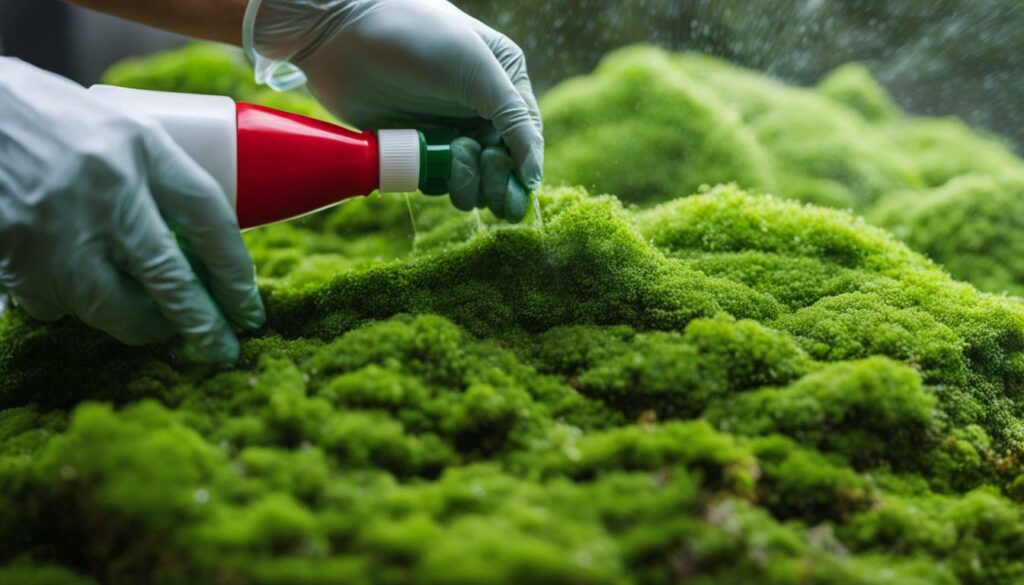
Ensuring the proper maintenance of your gutters is crucial for the overall health of your roof and home. Regular cleaning and maintenance will help prevent water damage, protect your roof from debris buildup, and maintain the structural integrity of your home foundation. Here are some essential tips for effective gutter maintenance:
- Inspect and Clean: Regularly inspect your gutters for leaves, twigs, and other debris that can clog them. Remove any buildup and clean your gutters thoroughly. Use a gutter scoop or a trowel to remove debris, and then rinse the gutters with a hose to clear away any remaining dirt.
- Check for Damage: While cleaning your gutters, take the opportunity to check for any signs of damage. Look for cracks, corrosion, or loose joints that may cause leaks or improper water drainage. If you notice any issues, repair or replace the damaged sections promptly.
- Ensure Proper Water Drainage: After cleaning your gutters, make sure they are properly aligned and securely attached to your roofline. Check that the downspouts are clear and free of obstructions. It’s essential to redirect water away from your home’s foundation to prevent water damage.
- Consider Gutter Guards: Install gutter guards to help prevent debris from entering and clogging your gutters. Gutter guards act as a barrier, allowing water to flow freely while keeping leaves and other debris out. This reduces the frequency of gutter cleaning and extends their lifespan.
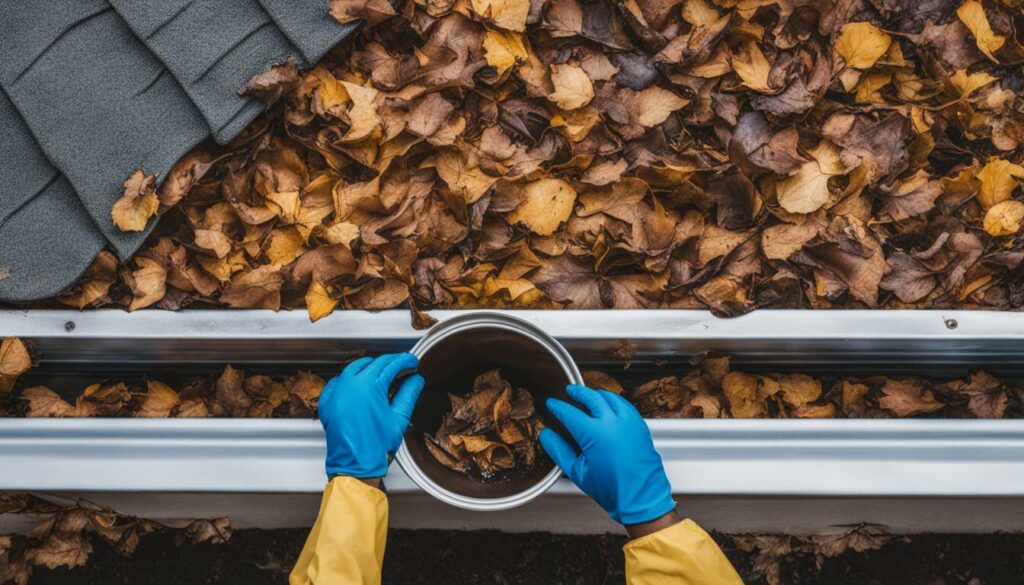
Regular maintenance of your gutters is a vital part of keeping your roof in good condition and protecting your home. By following these gutter maintenance tips, you can ensure proper water drainage, prevent damage to your roof and foundation, and avoid costly repairs down the line.
Section 5: Remove Leaves and Debris from Your Roof
Regularly removing leaves and debris from your roof is essential for maintaining its integrity and preventing the growth of moss, lichen, and algae. Over time, fallen leaves and debris can accumulate, creating a conducive environment for these organisms to thrive. By taking proactive measures to remove them, you can prevent damage and prolong the lifespan of your roof.
To effectively remove leaves and debris from your roof, follow these simple steps:
- Start by using a ladder to access your roof safely. Ensure the ladder is stable and secure before climbing up.
- Once on the roof, use a leaf blower or a broom to gently sweep away the leaves and debris. Avoid using excessive force, as this may damage the shingles or other roofing materials.
- If moss, lichen, or algae are present, you can use a soft-bristle brush or a pressure washer with a low-pressure setting to remove them. However, exercise caution to avoid causing any damage to the roof surface.
- After removing the leaves and debris, ensure that your gutters and downspouts are clear of any obstructions. Use a garden hose to flush out any remaining debris and check for proper water flow.
By regularly cleaning your roof and ensuring it remains free of leaves and debris, you can prevent the accumulation of moisture and reduce the risk of roof damage. Remember to always prioritize safety when accessing your roof, and consider hiring a professional if you are unsure or uncomfortable performing maintenance tasks yourself.
Table 1: Benefits of Removing Leaves and Debris from Your Roof
| Benefit | Description |
|---|---|
| Prevents water damage | Removing leaves and debris helps to maintain proper water drainage, preventing water from pooling and seeping into your roof. |
| Prevents moss, lichen, and algae growth | Regular removal of debris reduces the accumulation of moisture, discouraging the growth of moss, lichen, and algae. |
| Preserves roof lifespan | By preventing moisture retention and potential damage, removing debris can help extend the lifespan of your roof. |
| Enhances curb appeal | A clean roof free of debris contributes to the overall aesthetics of your home and improves curb appeal. |
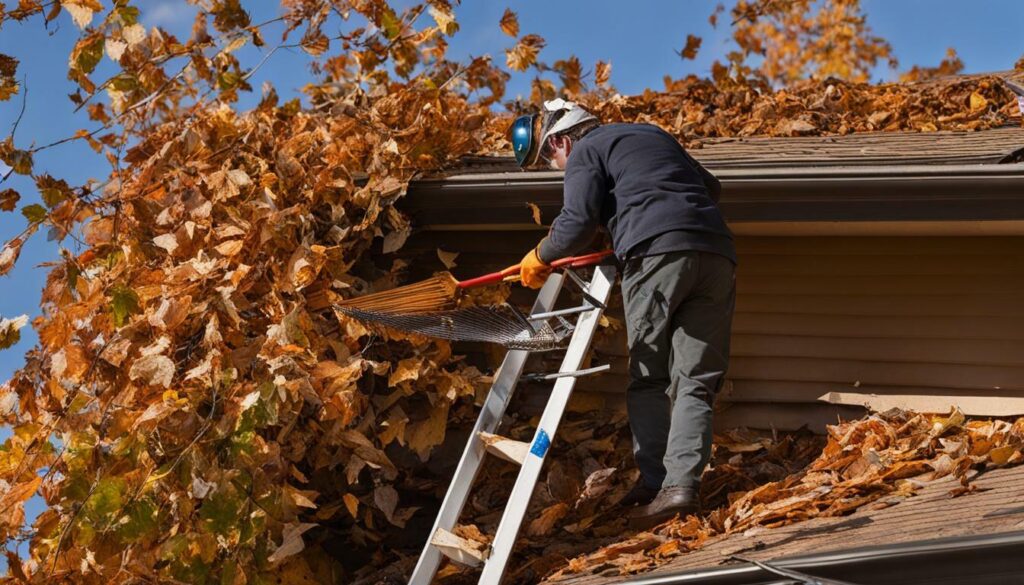
“Regularly removing leaves and debris from your roof is crucial for preventing damage and inhibiting the growth of moss, lichen, and algae.” – Roofing Maintenance Experts
Remember, maintaining a clean and debris-free roof is an important aspect of protecting your home and ensuring the longevity of your roof. By following these tips and investing in regular maintenance, you can enjoy a healthier and more secure living environment.
Trim Branches Hanging Near Your Roofline
One often overlooked aspect of roof maintenance is the trimming of tree branches that hang near your roofline. While beautiful, overhanging branches can pose a serious risk to the integrity of your roof, especially during storms. Falling branches can cause significant damage, leading to costly repairs.
To prevent such damage, it is crucial to regularly trim and prune any branches that are in close proximity to your roofline. By keeping trees well-maintained and ensuring no branches are touching or leaning on your roof, you can minimize the risk of storm damage and protect your home.
| Benefits of Tree Branch Trimming | How to Trim Tree Branches Safely |
|---|---|
|
|
“Regularly trimming tree branches near your roofline is an essential step in preventing storm damage. By taking the time to ensure that no branches are in contact with your roof, you can protect your home and avoid costly repairs.” – Roofing Expert
Consult with Professionals
If you are unsure about how to safely trim tree branches or if you have large, overhanging branches that require special equipment, it is advisable to consult with professional arborists. They have the expertise, tools, and experience to safely trim branches near your roofline, minimizing the risk of damage and ensuring the health of your trees.
Remember, when it comes to maintaining the integrity of your roof and protecting your home, proactive measures such as trimming branches are key. By taking the time to address potential risks, you can enjoy peace of mind during inclement weather and ensure the longevity of your roof.

Proper maintenance of your roof’s flashings is essential for maintaining the integrity of your roof and preventing water damage. Flashings are thin strips of metal or other materials that create water-tight seals around areas of your roof where water could potentially penetrate, such as chimneys, vents, and skylights.
To ensure your flashings continue to provide adequate protection, it is important to replace the caulk around them annually. Over time, caulk can deteriorate due to exposure to harsh weather conditions and UV rays. This can lead to cracks and gaps, compromising the water-tight seal.
When replacing the caulk around flashings, it is crucial to use a high-quality caulk specifically designed for roofing applications. This will ensure a durable and long-lasting seal. It is also important to thoroughly clean the area before applying the new caulk, removing any dirt, debris, or old caulk residue. Follow the manufacturer’s instructions for proper application and allow the caulk to cure fully before exposing it to rain or extreme weather conditions.
Table: Steps for Annual Replacement of Caulk around Flashings
| Step | Description |
|---|---|
| 1 | Clean the area around the flashing using a wire brush or similar tool to remove any debris. |
| 2 | Apply a caulk remover to ensure all remnants of old caulk are completely removed. |
| 3 | Apply a bead of high-quality roofing caulk around the flashing, ensuring full coverage and a smooth finish. |
| 4 | Smooth the caulk using a caulk smoothing tool or your finger, ensuring a water-tight and aesthetically pleasing finish. |
| 5 | Allow the caulk to dry and cure fully before exposing it to rain or extreme weather conditions. |
By replacing the caulk around your roof’s flashings annually, you can maintain water-tight seals and prevent potential leaks and water damage to your home. If you are unsure about performing this maintenance task yourself, it is always advisable to consult with a professional roofing contractor who has the necessary knowledge and experience to ensure the job is done correctly.
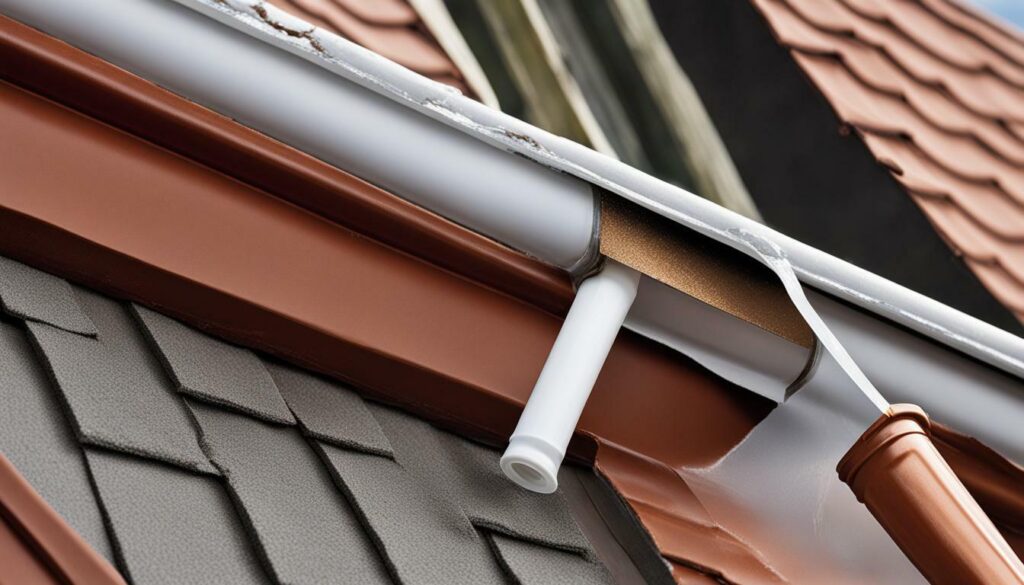
One often overlooked but crucial aspect of roof maintenance is ensuring that your attic has proper insulation. Adequate insulation is essential for preventing issues such as ice dams and damage caused by melting snow. By taking the necessary steps to insulate your attic, you can protect your roof and home from potential snow-related damage.
Insufficient insulation can lead to the formation of ice dams, which occur when heat from inside your home escapes through the roof and causes snow to melt. The melted snow then refreezes along the edges of your roof, creating a dam that prevents proper water drainage. As the dam expands, the trapped water can seep under your shingles, causing leaks and water damage to your home’s interior.
To prevent ice dams and mitigate snow damage, it is essential to ensure your attic has proper insulation. This insulation acts as a barrier, preventing heat from escaping and keeping your roof’s surface at a consistent temperature. By maintaining a cold roof surface, you can minimize the risk of snow melting and forming ice dams.
Consulting with a professional insulation contractor is recommended to assess your attic’s insulation levels and determine if any upgrades or improvements are necessary. They can evaluate your current insulation and recommend the most suitable insulation materials and techniques to ensure optimal energy efficiency and protection against ice dams and snow-related damage.
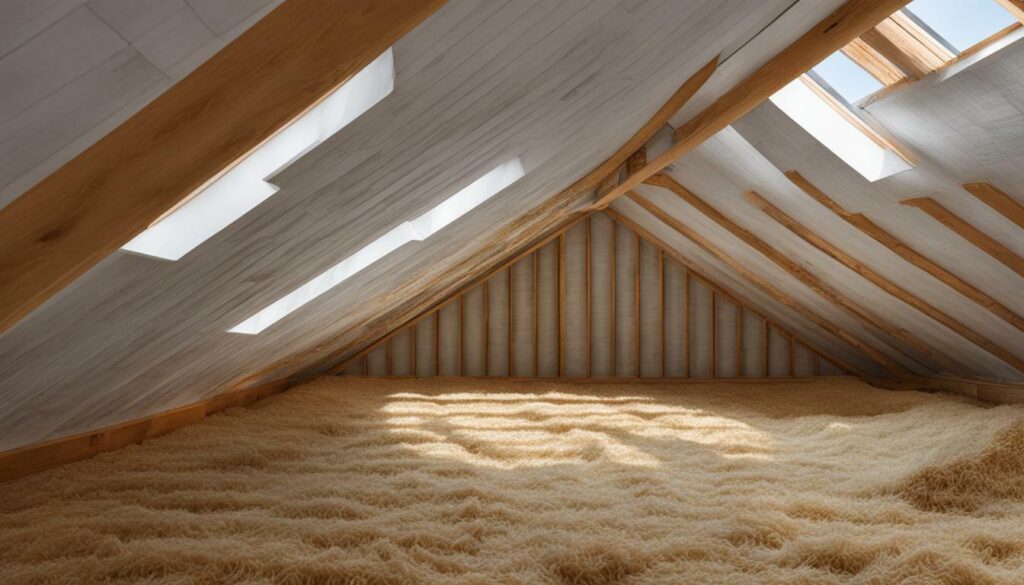
Remember, proper attic insulation is a key component of roof maintenance. By investing in adequate insulation and seeking professional advice, you can protect your roof from ice dams, prevent snow damage, and ensure the longevity of your home.
Mitigate the Effects of Sun Exposure
When it comes to protecting your roof, understanding the impact of sun exposure is vital. The sun’s rays can cause significant damage over time, leading to premature aging and deterioration of your roof. However, there are steps you can take to mitigate these effects and prolong the life of your roof.
The Role of Roof Protection
Installing roof protection measures is crucial in minimizing the damage caused by the sun. One effective method is the application of a reflective coating on your roof surface. This coating helps to reduce the amount of heat absorbed by your roof, keeping it cooler and preventing excessive expansion and contraction that can lead to cracks and leaks.
Additionally, ensuring proper ventilation in your attic can help regulate the temperature underneath your roof. This prevents the buildup of heat and moisture, which can accelerate the deterioration of roofing materials. A well-ventilated attic promotes airflow and helps maintain a stable environment that protects your roof.
Consult with Professionals
When it comes to mitigating the effects of sun exposure, it is essential to consult with roofing professionals. They have the expertise and knowledge to assess your roof’s condition and recommend the most suitable solutions. Whether it’s installing sun-resistant roofing materials, improving insulation, or implementing a maintenance plan, their guidance will ensure your roof remains protected for years to come.
“The sun’s rays can cause significant damage over time, leading to premature aging and deterioration of your roof.”
| Roof Protection Tips |
|---|
| 1. Apply a reflective coating to minimize heat absorption and prevent cracks and leaks. |
| 2. Ensure proper ventilation in your attic to regulate temperature and prevent moisture buildup. |
| 3. Consider installing sun-resistant roofing materials for added protection. |
To keep your roof in optimal condition, it is crucial to remain proactive and address any signs of sun damage promptly. Regular inspections and maintenance, combined with professional consultation, will ensure that your roof remains strong, durable, and protected against the harmful effects of sun exposure.
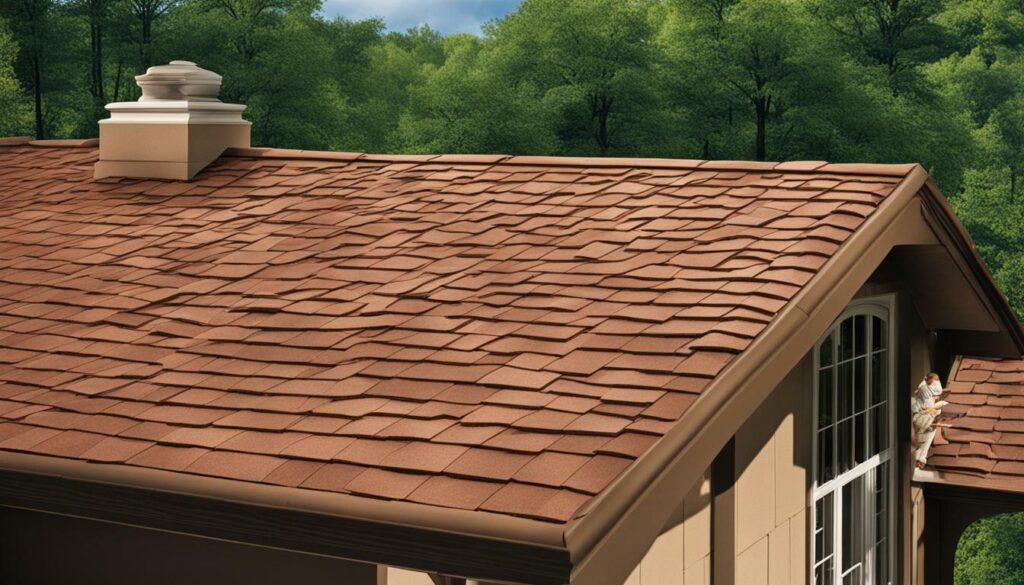
Regular roof maintenance is crucial for protecting your home and ensuring the longevity of your roof. By following these essential roof maintenance tips, you can safeguard your investment and avoid costly repairs down the line.
Thoroughly inspect your shingles each season for signs of wear or damage. Catching and addressing issues early on can prevent further damage and extend the life of your roof.
Treating for moss, lichen, and algae annually is vital to maintain the appearance and structural integrity of your roof. These organisms can cause significant damage if left unchecked, so it’s important to take proactive measures to prevent their growth.
Regularly cleaning and maintaining your gutters is key to proper water drainage and preventing damage to your roof and home foundation. Clearing away debris ensures that water is properly directed away from your roof, mitigating the risk of leaks and structural issues.
Removing leaves and debris from your roof on a regular basis is essential for preventing damage and inhibiting the growth of moss, lichen, and algae. By keeping your roof free from obstructions, you can maintain its integrity and prolong its lifespan.
Trimming branches that hang near your roofline is an important step in preventing damage caused by falling branches during storms. By proactively addressing potential risks, you can minimize the chances of roof damage and ensure your safety.
Annual replacement of caulk around flashings is necessary to maintain water-tight seals, preventing leaks and water damage. This simple maintenance task can go a long way in preserving the integrity of your roof.
Ensuring adequate insulation in your attic helps prevent ice dams and damage caused by melting snow. Proper insulation regulates temperature and prevents the buildup of snow and ice that can cause structural issues.
Understanding the impact of sun exposure on your roof is crucial. Working with professionals who can provide guidance on protective measures can help mitigate the effects of sun damage and extend the life of your roof.
Lastly, it’s important to trust professional experts for all maintenance and repairs. They have the knowledge, experience, and tools to ensure the longevity of your roof and keep your home safe and secure.
FAQ
Q: How often should I inspect my shingles?
A: It is recommended to thoroughly inspect your shingles each season for signs of wear or damage. This regular inspection will help you identify any issues early on and address them promptly.
Q: How do I treat moss, lichen, and algae on my roof?
A: Moss, lichen, and algae can be treated annually to prevent damage and maintain the appearance of your roof. There are various products available specifically designed for this purpose. Follow the instructions on the product label and ensure proper coverage to effectively treat and prevent the growth of these organisms.
Q: How often should I clean and maintain my gutters?
A: It is important to clean and maintain your gutters regularly to ensure proper water and debris drainage. Experts recommend cleaning gutters at least twice a year, in the spring and fall. Regular maintenance will prevent clogs and potential damage to your roof and home foundation.
Q: Why should I remove leaves and debris from my roof?
A: Regularly removing leaves and debris from your roof is crucial for preventing damage and inhibiting the growth of moss, lichen, and algae. These organisms can cause structural damage and compromise the integrity of your roof. By keeping your roof clear of debris, you reduce the risk of water retention and subsequent damage.
Q: How can trimming tree branches near my roofline help?
A: Trimming branches hanging near your roofline is important to prevent damage caused by falling branches during storms. Overhanging branches can scrape and damage your roof, leading to leaks and other issues. By keeping branches trimmed, you minimize the risk of roof damage and ensure the safety of your home.
Q: Why is it necessary to replace caulk around flashings annually?
A: Flashings play a vital role in keeping your roof watertight. Over time, caulk around flashings can deteriorate, leading to water leaks and potential damage. By replacing the caulk annually, you ensure water-tight seals and maintain the integrity of your roof.
Q: How does attic insulation prevent ice dams and snow damage?
A: Adequate attic insulation is essential for preventing ice dams and damage caused by melting snow. Proper insulation keeps your attic space cold, preventing snow from melting and refreezing on your roof. This helps maintain the integrity of your roof and prevents water damage inside your home.
Q: What can I do to mitigate the effects of sun exposure on my roof?
A: Sun exposure can deteriorate your roof over time. To mitigate its effects, consider using UV-protective coatings or materials on your roof. Additionally, consulting with professionals specializing in roof protection can help you identify the best strategies to prevent sun damage and prolong the life of your roof.
Q: Why should I trust professional experts for roof maintenance and repairs?
A: Professional experts have the knowledge, experience, and tools necessary to provide quality maintenance and repairs for your roof. Trusting professionals ensures the longevity and safety of your roof, as they can identify and address issues effectively. Don’t hesitate to seek their assistance to keep your roof in optimal condition.

